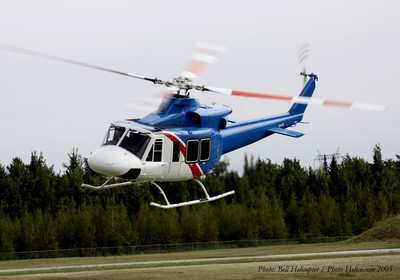Thu, Jul 22, 2010
Potential Low-Cost Option For Hover-Hold And SAR Missions
 Bell Helicopter, working in
cooperation with Esterline CMC Electronics, has developed and
flight tested a new generation GPS sensor to replace existing
high-cost Doppler or inertial velocity sensors used in automated
approach-to-hover and hover-hold systems.
Bell Helicopter, working in
cooperation with Esterline CMC Electronics, has developed and
flight tested a new generation GPS sensor to replace existing
high-cost Doppler or inertial velocity sensors used in automated
approach-to-hover and hover-hold systems.
This new product is anticipated to be available for installation
on the Bell 412EP within the next 12-months with plans to expand
availability to other models.
"The CMC GPS solution proved more responsive in flight test than
both the legacy Doppler and any of the GPS-aided inertial solutions
being examined when tied to the existing 412EP autopilot, but this
is not just for SAR and hover-hold," said Bell's chief technology
officer, Nick Lappos. "We see this technology and the capability it
brings as a means to improve safety in low-speed operations in
general as well as reduce the cost of SAR operations."
The Bell-CMC ground velocity sensor is designed to work with the
existing autopilot systems the Bell-CMC ground velocity sensor
provides law enforcement and emergency medical service (EMS)
operators with significant SAR safety enhancements at an affordable
price.

Bell 412 File Photo
This new offering will provide immediate benefit for Bell 412EP
operators by reducing weight, minimizing installation requirements,
and improving stabilized hover-hold performance. Unaffected by
glassy water, tall grass, under-slung objects or other situations,
the new Bell-CMC sensor avoids many operational constraints that
have traditionally challenged the performance of Doppler
systems.
Established as a stand-alone software upgrade to the Esterline
CMC Electronics CMA-5024 satellite based augmentation systems
(SBAS) GPS receiver, the new Bell-CMC low-cost ground velocity
sensor processes a specific property of the raw GPS signals to
produce an actual velocity measurement versus reporting changes in
GPS positions over time.
Taking advantage of the processing power and high-update rate of
the CMA-5024, and not being limited to WAAS/SBAS coverage, the
system's ground velocity function is usable world-wide.
More News
Aero Linx: Model Aeronautical Association of Australia MAAA clubs are about fun flying, camaraderie and community. For over 75 years, the MAAA has been Australia’s largest fl>[...]
Touchdown Zone Lighting Two rows of transverse light bars located symmetrically about the runway centerline normally at 100 foot intervals. The basic system extends 3,000 feet alon>[...]
“Discovery and innovation are central to our mission at Virgin Galactic. We’re excited to build on our successful record of facilitating scientific experiments in subor>[...]
How To Get A Story On Aero-TV News/Feature Programming How do I submit a story idea or lead to Aero-TV? If you would like to submit a story idea or lead, please contact Jim Campbel>[...]
Student Pilot Reported That During Rotation, “All Of A Sudden The Back Of The Plane Kicked To The Right..." Analysis: The student pilot reported that during rotation, “>[...]
 ANN's Daily Aero-Linx (05.02.24)
ANN's Daily Aero-Linx (05.02.24) ANN's Daily Aero-Term (05.02.24): Touchdown Zone Lighting
ANN's Daily Aero-Term (05.02.24): Touchdown Zone Lighting Aero-News: Quote of the Day (05.02.24)
Aero-News: Quote of the Day (05.02.24) ANN FAQ: Contributing To Aero-TV
ANN FAQ: Contributing To Aero-TV NTSB Final Report: Cirrus Design Corp SR20
NTSB Final Report: Cirrus Design Corp SR20




